Everyday Phenomena: The Maillard Reaction




Everyday Phenomena: The Maillard Reaction
At first glance, steak, French fries, bread, milk caramel, and soy sauce don’t have very many similarities. However, the preparation of these foods all have one thing in common: browning that occurs via the Maillard (my-YAR) reaction.
The Maillard reaction was first discovered in 1912 by Louis-Camille Maillard, and refers to a long chain of reactions that ultimately leads to browning of food. This chain typically begins with the condensation of an amine (often the amino acid lysine) with a reducing sugar (containing an aldehyde); one example of this Amadori rearrangement is shown above with lysine and glucose.
This Amadori product can react in a variety of different ways, including dehydration and deamination to produce a diverse array of molecules that give browned food a distinctive flavor; a few of these compounds are shown above. At the end of the sequence of reactions that occur during browning is a class of polymeric compounds known as melanoidins, which lend a brown color to the food.
Below about 140°C (280°F), the Maillard reaction does not proceed at an appreciable rate, although alkaline conditions (such as the lye used to make pretzels) can accelerate the process. Without this reaction, many foods we enjoy now wouldn’t be nearly as tasty!
Further Reading: Hodge, J. E., J. Agric. Food Chem. 1953, 1 (15), 928-943 (Full text)
More Posts from Philosophical-amoeba and Others



Throughout the Watergate scandal, Richard Nixon and his supporters accused the press of being biased against his administration. In response to the criticism, Time, which had done significant investigative work on Watergate, took a moment for self-reflection with a July 8, 1974, cover story examining the press’ role in the event. Weighing the notion that the press had become too involved for its own good, the magazine still concluded that further investigation was necessary:
“If the press were to stop digging, analyzing and attempting to keep the record straight, the investigative momentum could easily falter once more. The press can help assure that the constitutional process continues to function. After all that has happened, the country is entitled to a definitive verdict.”
Nevertheless, accusations persisted that Time and other publications were merely pursuing a liberal agenda. In February 1976 Reed Irvine and his conservative organization Accuracy in Media bought a full-page ad in the Washington Post to print a story alleging that Democratic National Committee officials knew about plans to break into the Watergate offices beforehand. The ad implied that the DNC was something other than an innocent victim and that the press had refused to make this assertion for partisan reasons. In this memo from Time’s Washington Bureau correspondent Hays Gorey to his editors, Gorey outlines the investigation done into the potential story and defends the consensus among his colleagues that it did not merit publication. He writes:
“I’m sure Reed Irvine can wow audiences by telling this story and claiming it is news being covered up. But where are his facts? Hundreds of Watergate stories went unwritten and unpublished because there were no facts to support them. This is one.“
Time July 8, 1974 cover reprint. Time Inc. Records. Editor-in-Chief: Hedley Donovan Files: Subject Files: 1959-1979: Time: Bias. New-York Historical Society.
Hays Gorey to Hedley Donovan, Henry Grunwald, and D. Duncan. February 27, 1976. Time Inc. Records. Editor-in-Chief: Hedley Donovan Files: Subject Files: 1959-1979: [Time: Bias: Kennedy and Nixon]. New-York Historical Society.
Processing of the Time Inc. Archive is made possible through the generous support of the Henry Luce Foundation

Rockfleet Castle, Co. Mayo, Ireland. It’s a former home of Grace O`Malley (Gráinne Mhaol), the famous 16th century ‘Pirate Queen’.
Photo: Mikeoem (CC-BY-SA-4.0 )
12 Amazing Facts About Elephants
In honor of World Elephant Day, we present you with 12 little known facts about one of our favorite creatures…in GIFs, of course.
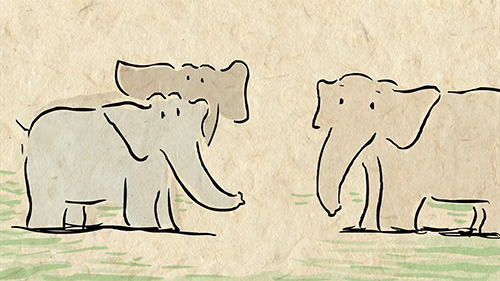
1. Elephants know every member of their herd and are able to recognize up to 30 companions by sight or smell.
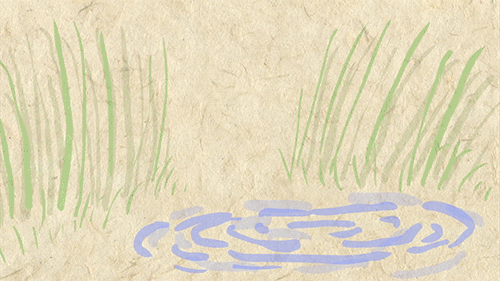
2. They can remember and distinguish particular cues that signal danger and can recall locations long after their last visit.
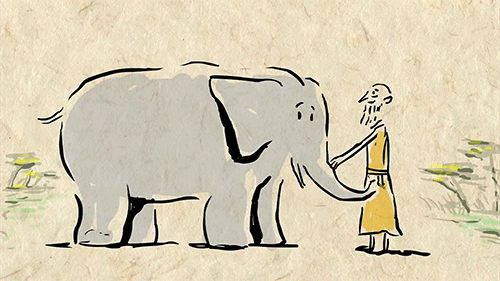
3. An elephant’s memory is not limited to its herd, nor is it limited to its species. In one instance, two circus elephants that performed together rejoiced when crossing paths 23 years later. Elephants have also recognized humans that they once bonded with after decades apart. 4.
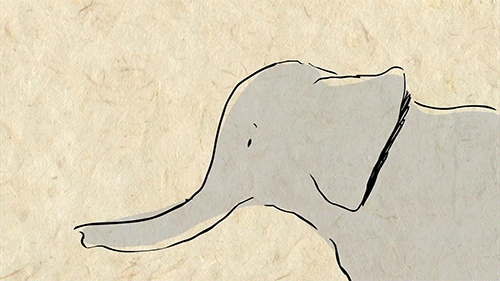
4. The elephant boasts the largest brain of any land mammal as well as an impressive encephalization quotient (the size of the animal’s brain relative to its body size). The elephant’s EQ is nearly as high as a chimpanzee’s.
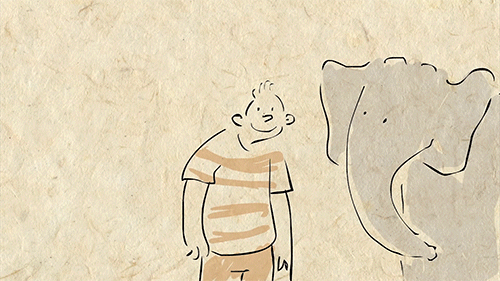
5. The elephant brain is remarkably similar to the human brain, with as many neurons and synapses, as well as a highly developed hippocampus and cerebral cortex.
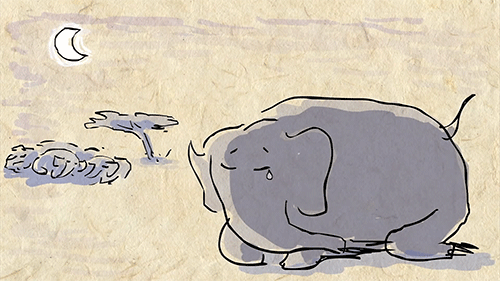
6. Elephants are one of the few non-human animals to suffer from post-traumatic stress disorder.

7. Elephants are creative problem solvers.
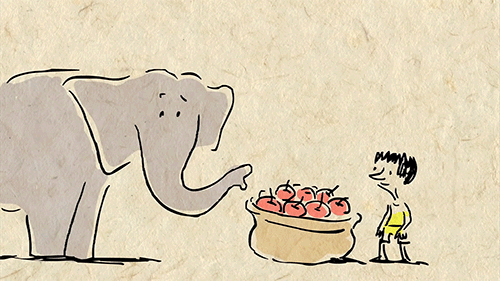
8. Don’t try to outsmart an elephant! They have an understanding of basic arithmetic and can even keep track of relative quantities.
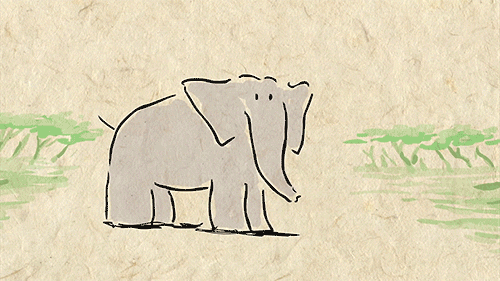
9. Elephants communicate using everything from body signals to infrared rumbles that can be heard from kilometers away. Their understanding of syntax suggests that they have their own language and grammar.
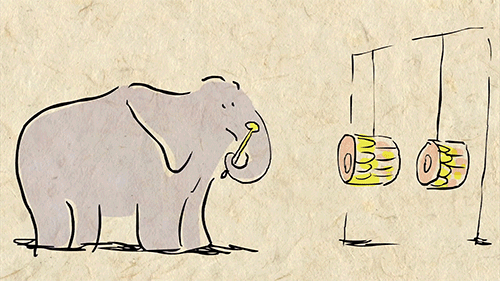
10. Elephants can recognize 12 distinct tones of music and recreate melodies.

11. Elephants are the only non-human animals to mourn their dead, performing burial rituals and returning to visit graves.
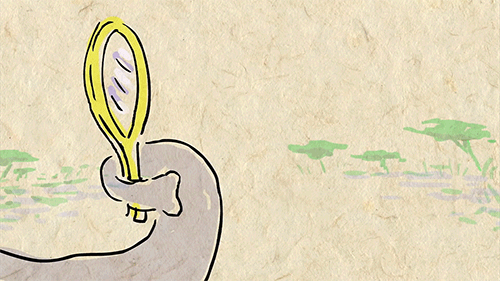
12. Elephants are one of the few species who can recognize themselves in the mirror.
Given what we now know about elephants, and what they continue to teach us about animal intelligence, it is more important than ever to make sure that these magnificent creatures do not vanish.
Check out some more fun elephant facts here and be sure to watch the TED-Ed Lesson Why elephants never forget - Alex Gendler
Animation by the ever-talented Avi Ofer



MALANG, INDONESIA
Kampung Warna-Warni (Village of Color)
This Indonesian village was revitalized by a vibrant rainbow paint job.
South of the city center in Malang, Indonesia, rows upon rows of monotonous white houses with brown roofs suddenly transform into a rainbow of vibrant colors bursting at every corner. What was formerly an impoverished village was transformed into an oasis of color and art, a project that has delighted visitors and revitalized the local community.
The village of Kampung Warna-Warni (Indonesian for “Village of Color”) was once drab and polluted, lacking the economic resources required to build a healthy community. But eight event management students from a nearby university lent a helping hand by applying their class skills to the real world. The students partnered with a local paint company looking to do a social responsibility project, which donated over 6,000 pounds of colorful paint, and voila, a hueless city got a brilliant new paint job.
Inspired by the favelas of Rio, every square inch of the rainbow village is coated in color, ranging from pastels of green and orange to pink and yellow. The bridge nearby the village is also painted, its beams erupting in magnificent blues and purples.
Although it may seem like the paint job would benefit visitors more than those actually living in the village, the makeover has revitalized the community. The beautiful colors improved the village’s standard of living by drawing in new tourist dollars, and the beauty of the colorful houses has inspired many community members to improve the sanitation of their river.

Samurai armour.
A chart I made showing the names of the various main components of a suit of “modern samurai armour” or tosei gusoku. Tosei gusoku refers to armour worn by samurai that began to appear during the middle of the Muromachi Period (1337-1573) with the introduction of firearms.
A full suit of tosei gusoku as shown in my chart would have weighed in at around 30 kilograms or so including weapons - there is after all a considerable amount of iron plates and lacing!
Lower class samurai such as foot soldiers (ashigaru) would have carried their own rations, bedding, and other equipment, but their armour was somewhat lighter being generally less ornamented.
At this point in time, known in Japanese history as the Sengoku Period or the Warring States Period, the most common samurai weapon was the spear followed by the bow and arrow. The sword at this point in time was a secondary weapon relied upon during close combat.
The sword carried during this period was the longer, gracefully curved tachi and was worn edge down on the left side supported either by it’s own tachi mounting (tachi koshirae) or by using a special leather “sling” (koshiate) if it was mounted without hangers (ashi).
Another shorter sword called a chisagatana - literally “little sword” - was carried together with the tachi at the left hip up until the Momoyama period (1573-1603) when it was abandoned. The chisagatana was originally a throw away weapon reserved for use by conscript foot soldiers (ashigaru), but higher ranking samurai soon took up the carrying of one as a back up weapon.
Higher ranked samurai, those in charge of troops and generals in particular, also carried a short stout blade called a metezashi at the right hip, with the handle facing forwards. This weapon was designed for extreme close combat and used to penetrate the weak spots in an opponents armour. When swords were crossed, the metezashi could be drawn with the left hand and thrust into the opponent’s armpits. It could also be drawn with the right hand and thrown underarm in an instant to distract and stun an opponent before following up with the sword.
© James Kemlo
List of medieval European scientists
Anthemius of Tralles (ca. 474 – ca. 534): a professor of geometry and architecture, authored many influential works on mathematics and was one of the architects of the famed Hagia Sophia, the largest building in the world at its time. His works were among the most important source texts in the Arab world and Western Europe for centuries after.
John Philoponus (ca. 490–ca. 570): also known as John the Grammarian, a Christian Byzantine philosopher, launched a revolution in the understanding of physics by critiquing and correcting the earlier works of Aristotle. In the process he proposed important concepts such as a rudimentary notion of inertia and the invariant acceleration of falling objects. Although his works were repressed at various times in the Byzantine Empire, because of religious controversy, they would nevertheless become important to the understanding of physics throughout Europe and the Arab world.
Paul of Aegina (ca. 625–ca. 690): considered by some to be the greatest Christian Byzantine surgeon, developed many novel surgical techniques and authored the medical encyclopedia Medical Compendium in Seven Books. The book on surgery in particular was the definitive treatise in Europe and the Islamic world for hundreds of years.
The Venerable Bede (ca. 672–735): a Christian monk of the monasteries of Wearmouth and Jarrow who wrote a work On the Nature of Things, several books on the mathematical / astronomical subject of computus, the most influential entitled On the Reckoning of Time. He made original discoveries concerning the nature of the tides and his works on computus became required elements of the training of clergy, and thus greatly influenced early medieval knowledge of the natural world.
Rabanus Maurus (c. 780 – 856): a Christian monk and teacher, later archbishop of Mainz, who wrote a treatise on Computus and the encyclopedic work De universo. His teaching earned him the accolade of "Praeceptor Germaniae," or "the teacher of Germany."
Abbas Ibn Firnas (810 – 887): a polymath and inventor in Muslim Spain, made contributions in a variety of fields and is most known for his contributions to glass-making and aviation. He developed novel ways of manufacturing and using glass. He broke his back at an unsuccessful attempt at flying a primitive hang glider in 875.
Pope Sylvester II (c. 946–1003): a Christian scholar, teacher, mathematician, and later pope, reintroduced the abacus and armillary sphere to Western Europe after they had been lost for centuries following the Greco-Roman era. He was also responsible in part for the spread of the Hindu-Arabic numeral system in Western Europe.
Maslamah al-Majriti (died 1008): a mathematician, astronomer, and chemist in Muslim Spain, made contributions in many areas, from new techniques for surveying to updating and improving the astronomical tables of al-Khwarizmi and inventing a process for producing mercury oxide.[citation needed] He is most famous, though, for having helped transmit knowledge of mathematics and astronomy to Muslim Spain and Christian Western Europe.
Abulcasis (936-1013): a physician and scientist in Muslim Spain, is considered to be the father of modern surgery. He wrote numerous medical texts, developed many innovative surgical instruments, and developed a variety of new surgical techniques and practices. His texts were considered the definitive works on surgery in Europe until the Renaissance.
Constantine the African (c. 1020&–1087): a Christian native of Carthage, is best known for his translating of ancient Greek and Roman medical texts from Arabic into Latin while working at the Schola Medica Salernitana in Salerno, Italy. Among the works he translated were those of Hippocrates and Galen.
Arzachel (1028–1087): the foremost astronomer of the early second millennium, lived in Muslim Spain and greatly expanded the understanding and accuracy of planetary models and terrestrial measurements used for navigation. He developed key technologies including the equatorium and universal latitude-independent astrolabe.
Avempace (died 1138): a famous physicist from Muslim Spain who had an important influence on later physicists such as Galileo. He was the first to theorize the concept of a reaction force for every force exerted.
Adelard of Bath (c. 1080 – c. 1152): was a 12th-century English scholar, known for his work in astronomy, astrology, philosophy and mathematics.
Avenzoar (1091–1161): from Muslim Spain, introduced an experimental method in surgery, employing animal testing in order to experiment with surgical procedures before applying them to human patients.[4] He also performed the earliest dissections and postmortem autopsies on both humans as well as animals.
Robert Grosseteste (1168–1253): Bishop of Lincoln, was the central character of the English intellectual movement in the first half of the 13th century and is considered the founder of scientific thought in Oxford. He had a great interest in the natural world and wrote texts on the mathematical sciences of optics, astronomy and geometry. In his commentaries on Aristotle's scientific works, he affirmed that experiments should be used in order to verify a theory, testing its consequences. Roger Bacon was influenced by his work on optics and astronomy.
Albert the Great (1193–1280): Doctor Universalis, was one of the most prominent representatives of the philosophical tradition emerging from the Dominican Order. He is one of the thirty-three Saints of the Roman Catholic Church honored with the title of Doctor of the Church. He became famous for his vast knowledge and for his defence of the pacific coexistence between science and religion. Albert was an essential figure in introducing Greek and Islamic science into the medieval universities, although not without hesitation with regard to particular Aristotelian theses. In one of his most famous sayings he asserted: "Science does not consist in ratifying what others say, but of searching for the causes of phenomena." Thomas Aquinas was his most famous pupil.
John of Sacrobosco (c. 1195 – c. 1256): was a scholar, monk, and astronomer (probably English, but possibly Irish or Scottish) who taught at the University of Paris and wrote an authoritative and influential mediaeval astronomy text, the Tractatus de Sphaera; the Algorismus, which introduced calculations with Hindu-Arabic numerals into the European university curriculum; the Compotus ecclesiasticis on Easter reckoning; and the Tractatus de quadrante on the construction and use of the astronomical quadrant.
Jordanus de Nemore (late 12th, early 13th century): was one of the major pure mathematicians of the Middle Ages. He wrote treatises on mechanics ("the science of weights"), on basic and advanced arithmetic, on algebra, on geometry, and on the mathematics of stereographic projection.
Villard de Honnecourt (fl. 13th century): a French engineer and architect who made sketches of mechanical devices such as automatons and perhaps drew a picture of an early escapement mechanism for clockworks.
Roger Bacon (1214–94): Doctor Admirabilis, joined the Franciscan Order around 1240 where, influenced by Grosseteste, Alhacen and others, he dedicated himself to studies where he implemented the observation of nature and experimentation as the foundation of natural knowledge. Bacon wrote in such areas as mechanics, astronomy, geography and, most of all, optics. The optical research of Grosseteste and Bacon established optics as an area of study at the medieval university and formed the basis for a continuous tradition of research into optics that went all the way up to the beginning of the 17th century and the foundation of modern optics by Kepler.[8]
Ibn al-Baitar (died 1248): a botanist and pharmacist in Muslim Spain, researched over 1400 types of plants, foods, and drugs and compiled pharmaceutical and medical encyclopedias documenting his research. These were used in the Islamic world and Europe until the 19th century.
Theodoric Borgognoni (1205-1296): was an Italian Dominican friar and Bishop of Cervia who promoted the uses of both antiseptics and anaesthetics in surgery. His written work had a deep impact on Henri de Mondeville, who studied under him while living in Italy and later became the court physician for King Philip IV of France.
William of Saliceto (1210-1277): was an Italian surgeon of Lombardy who advanced medical knowledge and even challenged the work of the renowned Greco-Roman surgeon Galen (129-216 AD) by arguing that allowing pus to form in wounds was detrimental to the health of he patient.
Thomas Aquinas (1227–74): Doctor Angelicus, was an Italian theologian and friar in the Dominican Order. As his mentor Albert the Great, he is a Catholic Saint and Doctor of the Church. In addition to his extensive commentaries on Aristotle's scientific treatises, he was also said to have written an important alchemical treatise titled Aurora Consurgens. However, his most lasting contribution to the scientific development of the period was his role in the incorporation of Aristotelianism into the Scholastic tradition.
Arnaldus de Villa Nova (1235-1313): was an alchemist, astrologer, and physician from the Crown of Aragon who translated various Arabic medical texts, including those of Avicenna, and performed optical experiments with camera obscura.
John Duns Scotus (1266–1308): Doctor Subtilis, was a member of the Franciscan Order, philosopher and theologian. Emerging from the academic environment of the University of Oxford. where the presence of Grosseteste and Bacon was still palpable, he had a different view on the relationship between reason and faith as that of Thomas Aquinas. For Duns Scotus, the truths of faith could not be comprehended through the use of reason. Philosophy, hence, should not be a servant to theology, but act independently. He was the mentor of one of the greatest names of philosophy in the Middle Ages: William of Ockham.
Mondino de Liuzzi (c. 1270-1326): was an Italian physician, surgeon, and anatomist from Bologna who was one of the first in Medieval Europe to advocate for the public dissection of cadavers for advancing the field of anatomy. This followed a long-held Christian ban on dissections performed by the Alexandrian school in the late Roman Empire.
William of Ockham (1285–1350): Doctor Invincibilis, was an English Franciscan friar, philosopher, logician and theologian. Ockham defended the principle of parsimony, which could already be seen in the works of his mentor Duns Scotus. His principle later became known as Occam's Razor and states that if there are various equally valid explanations for a fact, then the simplest one should be chosen. This became a foundation of what would come to be known as the scientific method and one of the pillars of reductionism in science. Ockham probably died of the Black Plague. Jean Buridan and Nicole Oresme were his followers.
Jacopo Dondi dell'Orologio (1290-1359): was an Italian doctor, clockmaker, and astronomer from Padua who wrote on a number of scientific subjects such as pharmacology, surgery, astrology, and natural sciences. He also designed an astronomical clock.
Richard of Wallingford (1292-1336): an English abbot, mathematician, astronomer, and horologist who designed an astronomical clock as well as an equatorium to calculate the lunar, solar and planetary longitudes, as well as predict eclipses.
Jean Buridan (1300–58): was a French philosopher and priest. Although he was one of the most famous and influent philosophers of the late Middle Ages, his work today is not renowned by people other than philosophers and historians. One of his most significant contributions to science was the development of the theory of impetus, that explained the movement of projectiles and objects in free-fall. This theory gave way to the dynamics of Galileo Galilei and for Isaac Newton's famous principle of Inertia.
Guy de Chauliac (1300-1368): was a French physician and surgeon who wrote the Chirurgia magna, a widely read publication throughout medieval Europe that became one of the standard textbooks for medical knowledge for the next three centuries. During the Black Death he clearly distinguished Bubonic Plague and Pneumonic Plague as separate diseases, that they were contagious from person to person, and offered advice such as quarantine to avoid their spread in the population. He also served as the personal physician for three successive popes of the Avignon Papacy.
John Arderne (1307-1392): was an English physician and surgeon who invented his own anesthetic that combined hemlock, henbane, and opium. In his writings, he also described how to properly excise and remove the abscess caused by anal fistula.
Nicole Oresme (c. 1323–82): was one of the most original thinkers of the 14th century. A theologian and bishop of Lisieux, he wrote influential treatises in both Latin and French on mathematics, physics, astronomy, and economics. In addition to these contributions, Oresme strongly opposed astrology and speculated about the possibility of a plurality of worlds.
Giovanni Dondi dell'Orologio (c. 1330-1388): was a clockmaker from Padua, Italy who designed the astarium, an astronomical clock and planetarium that utilized the escapement mechanism that had been recently invented in Europe. He also attempted to describe the mechanics of the solar system with mathematical precision.
What’s Up for May 2016?

What’s Up for May? Two huge solar system highlights: Mercury transits the sun and Mars is closer to Earth than it has been in 11 years.

On May 9, wake up early on the west coast or step out for coffee on the east coast to see our smallest planet cross the face of the sun. The transit will also be visible from most of South America, western Africa and western Europe.

A transit occurs when one astronomical body appears to move across the face of another as seen from Earth or from a spacecraft. But be safe! You’ll need to view the sun and Mercury through a solar filter when looking through a telescope or when projecting the image of the solar disk onto a safe surface. Look a little south of the sun’s Equator. It will take about 7 ½ hours for the tiny planet’s disk to cross the sun completely. Since Mercury is so tiny it will appear as a very small round speck, whether it’s seen through a telescope or projected through a solar filter. The next Mercury transit will be Nov. 11, 2019.

Two other May highlights involve Mars. On May 22 Mars opposition occurs. That’s when Mars, Earth and the sun all line up, with Earth directly in the middle.

Eight days later on May 30, Mars and Earth are nearest to each other in their orbits around the sun. Mars is over half a million miles closer to Earth at closest approach than at opposition. But you won’t see much change in the diameter and brightness between these two dates. As Mars comes closer to Earth in its orbit, it appears larger and larger and brighter and brighter.

During this time Mars rises after the sun sets. The best time to see Mars at its brightest is when it is highest in the sky, around midnight in May and a little earlier in June.

Through a telescope you can make out some of the dark features on the planet, some of the lighter features and sometimes polar ice and dust storm-obscured areas showing very little detail.

After close approach, Earth sweeps past Mars quickly. So the planet appears large and bright for only a couple weeks.

But don’t worry if you miss 2016’s close approach. 2018’s will be even better, as Mars’ close approach will be, well, even closer.
You can find out about our #JourneytoMars missions at mars.nasa.gov, and you can learn about all of our missions at http://www.nasa.gov.
Make sure to follow us on Tumblr for your regular dose of space: http://nasa.tumblr.com
The math trick that college will never teach you! : Parametric Integration
Parametric integration is one such technique that once you are made aware of it, you will never for the love of god forget it. It goes by many names : ‘Differentiation under the Integral sign’, ‘Feynman’s famous trick’ , ‘Parametric Integration’ and so on.
Let me demonstrate :
Now this integral might seem familiar to you if you have taken a calculus course before and to evaluate it is rather simple as well.

Knowing this you can do lots of crazy stuff. Lets differentiate this expression wrt to the parameter in the integral – s (Hence the name parametric integration ). i.e


Look at that, by simple differentiation we have obtained the expression for another integral. How cool is that! It gets even better.
Lets differentiate it once more:


.
.
.
If you keep on differentiating the expression n times, one gets this :

Now substituting the value of s to be 1, we obtain the following integral expression for the factorial. This is known as the gamma function.

There are lots of ways to derive the above expression for the gamma function, but parametric integration is in my opinion the most subtle way to arrive at it. :D
This is a really powerful technique and I strong suggest that if you have taken calculus, then please do read this article.
Have a great day!
EDIT: It had to be gamma(n+1) not gamma(n) .Thank you @mattchelldavis
The alleged lexical extravagance of the Eskimos comports so well with the many other facets of their polysynthetic perversity: rubbing noses; lending their wives to strangers; eating raw seal blubber; throwing grandma out to be eaten by polar bears; “ We are prepared to believe almost anything about such an unfamiliar and peculiar group,” says Martin, in a gentle reminder of our buried racist tendencies. The tale she tells is an embarrassing saga of scholarly sloppiness and popular eagerness to embrace exotic facts about other people’s languages without seeing the evidence. The fact is that the myth of the multiple words for snow is based on almost nothing at all. It is a kind of accidentally developed hoax perpetrated by the anthropological linguistics community on itself. The original source is Franz Boas’ introduction to The Handbook of North American Indians (1911). And all Boas says there, in the context of a low-key and slightly ill-explained discussion of independent versus derived terms for things in different languages, is that just as English uses separate roots for a variety of forms of water (liquid, lake, river, brook, rain, dew, wave, foam) that might be formed by derivational morphology from a single root meaning ‘water’ in some other language, so Eskimo uses the apparently distinct roots aput 'snow on the ground’, qana 'falling snow’, piqsirpoq 'drifting snow’, and qimuqsuq 'a snow drift’. Boas’ point is simply that English expresses these notions by phrases involving the root snow, but things could have been otherwise, just as the words for lake, river, etc. could have been formed derivationally or periphrastically on the root water. But with the next twist in the story, the unleashing of the xenomorphic fable of Eskimo lexicography seems to have become inevitable. What happened was that Benjamin Lee Whorf, Connecticut fire prevention inspector and weekend language-fancier, picked up Boas’ example and used it, vaguely, in his 1940 amateur linguistics article 'Science and linguistics,’ which was published in MIT’s promotional magazine Technology Review (Whorf was an alumnus; he had done his B.S. in chemical engineering at MIT). Our word snow would seem too inclusive to an Eskimo, our man from the Hartford Fire Insurance Company confidently asserts. With an uncanny perception into the hearts and minds of the hardy Arctic denizens (the more uncanny since Eskimos were not a prominent feature of Hartford’s social scene at the time), he avers: “We have the same word for falling snow, snow on the ground, snow packed hard like ice, slushy snow, wind-driven flying snow – whatever the situation may be. To an Eskimo, this all-inclusive word would be almost unthinkable; he would say that falling snow, slushy snow, and so on, are sensuously and operationally different.” […] Notice that Whorf’s statement has illicitly inflated Boas’ four terms to at least seven (1: “falling”, 2: “on the ground”, 3: “packed hard”, 4: “slushy”, 5: “flying”, 6, 7 …. : “and other kinds of snow”). Notice also that his claims about English speakers are false; I recall the stuff in question being called “snow” when fluffy and white, “slush” when partly melted, “sleet” when falling in a half-melted state, and a “blizzard” when pelting down hard enough to make driving dangerous. Whorf’s remark about his own speech community is no more reliable than his glib generalizations about what things are “sensuously and operationally different” to the generic Eskimo. But the lack of little things like verisimilitude and substantiation are not enough to stop a myth. Martin tracks the great Eskimo vocabulary hoax through successively more careless repetitions and embroiderings in a number of popular books on language. […] But never mind: three, four, seven, who cares? It’s a bunch, right? Once more popular sources start to get hold of the example, all constraints are removed: arbitrary numbers are just made up as the writer thinks appropriate for the readership. […] Among the many depressing things about this credulous transmission and elaboration of a false claim is that even if there were a large number of roots for different snow types in some Arctic language, this would not, objectively, be intellectually interesting; it would be a most mundane and unremarkable fact. Horsebreeders have various names for breeds, sizes, and ages of horses; botanists have names for leaf shapes; interior decorators have names for shades of mauve; printers have many different names for different fonts (Caslon, Garamond, Helvetica, Times Roman, and so on), naturally enough. If these obvious truths of specialization are supposed to be interesting facts about language, thought, and culture, then I’m sorry, but include me out. Would anyone think of writing about printers the same kind of slop we find written about Eskimos in bad linguistics textbooks? Take a random textbook like Paul Gaeng’s Introduction to the Principles of Language (1971), with its earnest assertion: “It is quite obvious that in the culture of the Eskimos… snow is of great enough importance to split up the conceptual sphere that corresponds to one word and one thought in English into several distinct classes…” (p. 137). Imagine reading: “It is quite obvious that in the culture of printers.., fonts are of great enough importance to split up the conceptual sphere that corresponds to one word and one thought among non-printers into several distinct classes…” Utterly boring, if even true. Only the link to those legendary, promiscuous, blubber-gnawing hunters of the icepacks could permit something this trite to be presented to us for contemplation.
Geoff Pullum, in The Great Eskimo Vocabulary Hoax. (via allthingslinguistic)
-
 sofitoretransformerbankai reblogged this · 8 years ago
sofitoretransformerbankai reblogged this · 8 years ago -
 justfollowingarts-blog liked this · 8 years ago
justfollowingarts-blog liked this · 8 years ago -
 arielfabulous reblogged this · 8 years ago
arielfabulous reblogged this · 8 years ago -
 chironstar reblogged this · 8 years ago
chironstar reblogged this · 8 years ago -
 otakukid123 liked this · 8 years ago
otakukid123 liked this · 8 years ago -
 119-17 liked this · 8 years ago
119-17 liked this · 8 years ago -
 cio-sama reblogged this · 8 years ago
cio-sama reblogged this · 8 years ago -
 cio-sama liked this · 8 years ago
cio-sama liked this · 8 years ago -
 seleenjager reblogged this · 8 years ago
seleenjager reblogged this · 8 years ago -
 aliror liked this · 8 years ago
aliror liked this · 8 years ago -
 literallynerm liked this · 8 years ago
literallynerm liked this · 8 years ago -
 ragingphoxx liked this · 8 years ago
ragingphoxx liked this · 8 years ago -
 wibblywobblyscienceywiencey reblogged this · 8 years ago
wibblywobblyscienceywiencey reblogged this · 8 years ago -
 jaster--mereel liked this · 8 years ago
jaster--mereel liked this · 8 years ago -
 cio-sama reblogged this · 8 years ago
cio-sama reblogged this · 8 years ago -
 catcatcaybdkdbcat-blog liked this · 8 years ago
catcatcaybdkdbcat-blog liked this · 8 years ago -
 tulog-na liked this · 8 years ago
tulog-na liked this · 8 years ago -
 the-fanciest-duck reblogged this · 8 years ago
the-fanciest-duck reblogged this · 8 years ago -
 the-fanciest-duck liked this · 8 years ago
the-fanciest-duck liked this · 8 years ago -
 scalar reblogged this · 8 years ago
scalar reblogged this · 8 years ago -
 musedrone liked this · 8 years ago
musedrone liked this · 8 years ago -
 dudeman13 liked this · 8 years ago
dudeman13 liked this · 8 years ago -
 hikari-no-kokoro reblogged this · 8 years ago
hikari-no-kokoro reblogged this · 8 years ago -
 zahrahnadiaputri reblogged this · 8 years ago
zahrahnadiaputri reblogged this · 8 years ago -
 zahrahnadiaputri liked this · 8 years ago
zahrahnadiaputri liked this · 8 years ago -
 zhangjiahan-blog liked this · 8 years ago
zhangjiahan-blog liked this · 8 years ago -
 adorkablestudy-blog liked this · 8 years ago
adorkablestudy-blog liked this · 8 years ago -
 biochemistryandbeyond-blog reblogged this · 8 years ago
biochemistryandbeyond-blog reblogged this · 8 years ago -
 adhrpr liked this · 8 years ago
adhrpr liked this · 8 years ago -
 adhrpr reblogged this · 8 years ago
adhrpr reblogged this · 8 years ago -
 tricks-of-radiance reblogged this · 8 years ago
tricks-of-radiance reblogged this · 8 years ago -
 scalar liked this · 8 years ago
scalar liked this · 8 years ago -
 logicheartsoul liked this · 8 years ago
logicheartsoul liked this · 8 years ago
A reblog of nerdy and quirky stuff that pique my interest.
291 posts






